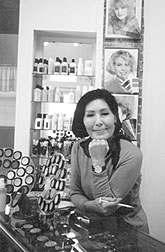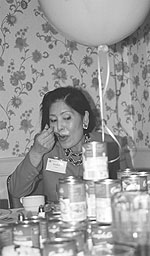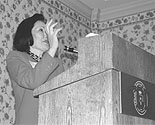Nestled in the stately old Fort Worth neighborhood known as Berkeley Place is a small plot that exudes tranquility, even from the street. A pebbled concrete path winds from the driveway to the front porch, the steps of which are lined with pots of purple and yellow pansies. The designer of this peaceful 1921 oasis is Keiko Couch, a Fort Worth image and Feng Shui consultant. She is reticent to share personal information, preferring instead to talk about her philosophy of using harmony in nature to create personal joy. By her own definition, she is Feng Shui. Her voice sounds like gently flowing water, low and softly rhythmic. Her words bubble forth in musical cadence. A listener might be carried away in the lilt of her speech, forgetting to listen to the words themselves. She wears red, a striking complement to her flawless skin and black hair. Red, she says, invites good energy. Her petite frame slides like a wisp of air down the walkway and through the gates to her studio. Born in Japan, Couch said she lived Feng Shui principles as part of her culture all her life without knowing it until a few years ago. Feng Shui is a 4,000-year-old Chinese art based on the premise that people enjoy happier, more prosperous lives when in harmony and balance. A universal energy called "chi" (pronounced CHEE) surrounds everything, giving energy and life. The job of ancient Feng Shui consultants was to locate villages away from bad winds and floods. "But in the 21st century, we have barking dogs next door and no space for front yard gardens," Couch said. "We have a straight concrete sidewalk leading to the front door, a tree placed here and another one on the other side. We have very little privacy. But there are a few things we can do at home to help chi come into our environment." In her environment, Couch tore up the straight sidewalk and had a curving path built to the front porch. She instructed the contractors to place rocks she brought from a beach on the East Coast near the edge of her sidewalk in random places. A window of her studio behind her house looks into her backyard garden where a small fountain trickles over a bed of rocks. Wind chimes near a window swallow up the sound of honking horns. Her studio is filled with light from windows, mirrors and an overhead skylight. Although Feng Shui originated in China, Couch said the Japanese language and lifestyle incorporate many of Feng Shui's principles. The idea of arranging environments for the best use of energy became popular in the United States about three years ago.
At the time, Couch was studying to get into the International Christian University, a competitive liberal arts institution in Tokyo. Her father, well-versed in English and German, was in contact with a family in North Texas who wanted a Japanese pen pal. After corresponding with Couch, who was learning English through the letter-writing process, the man asked her father if she would like to stay with the family for a year in the United States. The man suggested that she attend school in Texas and then try to get into the International Christian University. She learned as much English as she could in the weeks before she embarked on an arduous 19-day boat trip toward her American adventure. Traveling alone and carrying a picture of her American host family, she sailed on an immigration boat headed for Brazil. About 20 of the passengers, including Couch, disembarked in Los Angeles, where she faced a 54-hour bus trip alone to Tyler, Texas. Classes started nine days later, and Couch said she was dismayed to learn that the English she studied in Japan was not what people at her new school were speaking. "I had learned British English," she said. "The lectures were difficult to catch, and I couldn't copy other students' notes because I couldn't read them." She also realized for the first time how it felt to be different, as she was the first Japanese exchange student to attend Tyler Junior College. "On campus I was all alone," she said, her calm voice rising slightly. "There were no other students with dark skin, and I really stood out." She said the thing that kept her "alive" during her first years in a foreign country was a sense of humor that she discovered and refined. "In Japanese culture, you're supposed to be serious in suffering, but people here joke, especially when they're in trouble," she said. Couch finished her studies at the junior college and found another sponsor who said she should pursue a degree in graphic arts. "I wanted to go to the Pratt Institute (in New York), but the University of North Texas was one of the top five (programs) in the nation, and my sponsor wanted me to stay close by," she said. A few months before she graduated from UNT, the young exchange student met Ernest Couch, a dashing American doctorate candidate at Tulane University in New Orleans. She graduated from UNT, then called North Texas State University, with a degree in graphic arts. She married Ernest Couch, and the couple eventually ended up in Fort Worth. "It was fate - it just happened," she said. "You remember, I was going to be here for just one year. Now it's 35-plus years. It's OK that I stay in Texas. I can probably return something I know." One day, a friend commented to Couch that the Japanese seem to have a good eye for color and invited Couch to analyze the suitability of his office décor. "He wanted me to see if he looked like the owner," she said. "And that was how I got into (image consulting). I was one of the first people in Texas to get into color and image consulting." Couch juggled a job working for TCU publications and nourishing her budding business while raising two small children. At one point, she was also taking night classes at TCU.
As an image consultant, Couch analyzes her clients' skin and eye tone and suggests colors and styles that enhance their appearance. First impressions are everything, she said. "A person should shine for a few seconds when she comes into a room," Couch said. "It's smart to invest in yourself a little bit. You don't buy a piece of clothing because it is on sale - it should be a well-selected piece, an investment. It may be that the more expensive one gives you more joy. If a great piece is also on sale, that's a bonus." By limiting a client to colors that suit that person, Couch said she can save people time and money when shopping because she narrows options, giving the person confidence in making choices. "Even a small change makes a person's life richer," she said. "When you get attention and compliments, you are happier. Those are small returns, but they are big for some of the women I have consulted. "It's so much fun. Sometimes even men say, 'I got this necktie by myself - did I do OK?'" She applies the same principles to her clients' living spaces. She encourages them to rid their homes and offices of clutter and to use color and light to create a tranquil, happy environment. One of her clients, Debbie Kemp, had just moved into a new home when Couch came to help her with furniture placement. "I never would have given the art of placement much credit, but there definitely is something to it," Kemp said. "By moving four things surrounding the TV, we cleaned out an entire corner of the room. They didn't belong there, and I knew they didn't. It made a dramatic difference." Kemp said they also applied the laws of yin and yang, bringing dark accents into light areas and light objects into dark spaces. "I had lots and lots of candles," she said. "We arranged where they were to give warmth in certain areas of the room. Where I have lots of iron in the house, she brought in other elements to soften the iron, like moving a plant near a cold place." Kemp said Couch didn't talk about chi or Feng Shui as she offered suggestions, but the two worked on actual placement of items, balancing warmth, cold and other elements. The result was everything Couch talks about in her seminars and classes.
Kemp said her mother experienced even more dramatic results than she did with furniture placement. "My mom moved a bed from one room to another, and the room never felt complete," she said. "She simply moved the bed according to where Keiko said it should be, and it was the difference between night and day. I never felt that effect, but I think that's fundamental. There are certain things we do that make us feel good, and with her expertise, we made positive changes." Couch spoke at TCU's International Women's Day celebration on March 8, giving simple suggestions for bringing contemporary homes more in balance with nature, including some of the concepts she has incorporated in her own home. Marcy Paul, program coordinator of the Women's Resource Center at TCU, said she invited Couch to speak because the emphasis of the celebration was balance. "There is a significant meaning to this celebration," she said. "It's not just fun and games. (Years ago), women were fighting for equal rights and better working conditions. They weren't allowed balance in their lives. Today's celebration is about helping ourselves and each other." Besides teaching Feng Shui classes at TCU, Couch has family ties to the university. Her husband is a biology professor here, and both of her children, a son and a daughter, graduated from TCU. Couch said she does little else but run her business these days. "I told my husband, 'I work all the time' and he said, 'But you love it!' And he is right," she said. "I can feel good Chi around me." It's no wonder. She follows the rules.
Jeri Petersen
What is Feng Shui? Literally, it means wind and water. Feng Shui is not related to any religion or belief system. It is a scientific discipline based on the analysis of energy. At its core is the concept of the bagua, an energy map in the shape of an octagon. It is based upon a set of theories and complex calculations derived from the I-Ching, the oldest book in Chinese history. Each side of the bagua represents a different aspect of life: career, wisdom and knowledge, family and health, wealth, fame, relationships, creativity and helpful people. This includes an in-depth understanding and application of the theories of yin and yang, along with balancing the Five Elements (fire, earth, metal, water and wood). Yin and yang, represented by a circle containing a light and dark half, symbolize balance in Chinese dualistic philosophy. The dark half, with a light dot in it, represents the dark, feminine, passive side. The light half contains a dark dot and stands for sun, light and masculine features. Each side contains a portion of the other side, illustrating the ideal balance in all things. Feng Shui teaches that placement of things in the environment can create a favorable circulation of the life force chi, promoting prosperity, peace and happiness. Conversely, bad Feng Shui can drain energy, increase illness and lead to misfortune. Keiko Couch, a Fort Worth Feng Shui consultant, said energy is a goal most people desire, whether they realize it or not. "A vivacious person is energetic - that makes sense," she said. "We like to be around people who have energy." On the other hand, she said sickness is a lack of energy, and it must be restored from nature for a person to be well. "It's a state of mind," Couch said. "How you feel about the world - the air and everything around you - makes you younger, vibrant." Feng Shui practitioners seek to arrange environments for the best flow of energy. "Chi likes a slow, meandering way," Couch said. "If you have a straight sidewalk to your front door, the chi keeps shooting like it's on a highway. A curved walkway will slow down the energy so it doesn't rush in the front door and right out the back." Couch said if a home has a straight sidewalk, flower pots can be arranged along the way to disturb the straight line. The front door is the focal point of the home, and it should welcome good energy, she said. "The front door can be painted red, or a red geranium can be placed near the door," Couch said. "It makes people think, 'I wonder who lives here.'" Getting chi to the front door is only the beginning of good Feng Shui, however. "Chi likes to come in the front door, like a spring breeze," she said. "You can feel it come in and meander through the rooms one at a time." But chi doesn't like clutter or dark places, so furniture and accessories must sometimes be rearranged. Dark spaces can be brightened with light-colored furniture, mirrors and lights. As for clutter - sometimes things just need to be thrown out, she said. "People in Texas think the bigger the better, the more the better," Couch said. "But it's really more about quality, what you really appreciate and love to live with. If you haven't used or worn something for a year, throw it away." Like people, chi is constantly alive and changing. People need to re-evaluate their surroundings occasionally to determine if chi is flowing through the environment, whether it's a closet, office, residence hall room or home, she said. Couch encourages her clients to look at nature for inspiration in their wardrobe and home décor. "In nature, nothing is sharp and square," she said. "Be in harmony with nature. Look at a room with your Feng Shui eyes. Use balance, like yin and yang. Set off dark areas with light objects. Where there are square corners, bring in some curves."
Jeri Petersen |
| The TCU Daily Skiff © 1998, 1999 Credits |
 Couch said she was ahead of her time when
she arrived in the United States as a foreign exchange student her first
year of college more than 30 years ago.
Couch said she was ahead of her time when
she arrived in the United States as a foreign exchange student her first
year of college more than 30 years ago. Now she is a successful businesswoman - giving seminars,
doing corporate and individual consultations in the United States and Japan
and teaching classes through TCU community education. Her clients include
Tokyo Disneyland, Isuzu Automobile Co., Burlington Northern & Santa
Fe Railway, Harris Methodist Hospital education department and Alcon Laboratories.
Now she is a successful businesswoman - giving seminars,
doing corporate and individual consultations in the United States and Japan
and teaching classes through TCU community education. Her clients include
Tokyo Disneyland, Isuzu Automobile Co., Burlington Northern & Santa
Fe Railway, Harris Methodist Hospital education department and Alcon Laboratories. "I absolutely feel better about my environment since
she came," Kemp said. "It's so true that even small things make
a big difference."
"I absolutely feel better about my environment since
she came," Kemp said. "It's so true that even small things make
a big difference."